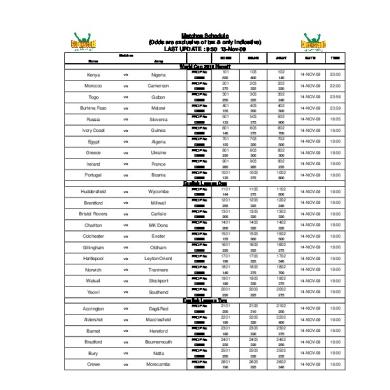Way Nov 14
This document was uploaded by user and they confirmed that they have the permission to share it. If you are author or own the copyright of this book, please report to us by using this DMCA report form. Report DMCA
Overview
Download & View Way Nov 14 as PDF for free.
More details
- Words: 615
- Pages: 2
Jaylin King Art 5100
“Curb Your Animal Instincts”: Semiotics Ilona Granet’s artwork, “Curb Your Animal Instincts,” supports the feminist ideals of Griselda Pollock and Roszika Parker through the medium used, the images depicted and through its intended use. Griselda Pollock and Roszika Parker presented a counter to Linda Nochlins feminist ideals of women artists gaining equality through equal opportunity. Parker and Pollock argue equal opportunity for female artists will not gain the same rights and privileges of male artists. Female art will always be construed as female, different, and othered as long as it is associated with the idea of woman or women. Pollock and Parker challenge the historical notion of “woman” and maintain that art is prescriptive not descriptive. Women artists will always be considered on a different level than male artists as long as their art is read as distinctly female and othered. Illona Granet’s work supports Parker and Pollock’s notions on the female artist and female art in a multitude of ways. One main aspect of the piece that contributes to Parker and Pollock’s feminist ideals is the material quality of the piece. This work is constructed of industrial steel rebar and sheet metal, construction and industrial paint, and mechanical nuts and bolts. There is no component of basket weaving, quilt sewing, watercolor or any other traditional female medium utilized. Illona’s work is constructed from materials classically recognized as belonging to the male domain. Strong, resilient materials intended for hard use, length of life, and large scale construction as opposed to smaller, crafty, and genteel materials intended to create delicate works of decoration. Another contributing factor to this pieces support of the notions of Parker and Pollock is the type and style of imagery used. The piece is composed of combined text and figural qualities, there is no traditional female landscape or flower imagery that would convince viewers that this piece was designed and created by a woman. The figural images depicted are hard edged, blocky, and somewhat abstract in their angular and agitated construction. The figures depicted are active, engaged, and aware. Even the female figure, with an impressively curvaceous physique, carries herself with an energetic, dynamic, and self aware energy, there is no suggestion of passivity, docility or submission. The active and engaged figures are designed as blocky and solid aspects, not subtle shading takes place, and everything is hard edged, black and white, even the text is blocky and solidly structural. Every aspect of the visual components of this work, lend themselves to male artistic ideals. The final mitigating factor to this pieces support of Parker and Pollock’s feminist ideals is the pieces intended use or display. The piece was created to act a prescriptive work of art, which is one of the founding principals of Parker and Pollock’s feminist argument. Sitting adjoined to a stop sign, Granet’s images suggest not a description of the world in which we live, but are a prescription for change. Granet created this work with the intent of altering or changing behavior on the streets of New York, she understands that her artwork can function to change the construct of society and does not merely represent it.
Illona Granets work, “Curb Your Animal Instincts,” is a piece constructed from traditionally male artistic materials, utilizing traditional male imagery and stylistic components, and encouraging societal development and change as opposed to accepting and representing society as it is. As such, her work exemplifies the principals of two feminist scholars, Griselda Pollock and Roszika Parker, who argue that women artists will never be equal to male artists, so long as there is a historically understood ideal of “woman,” and that art is prescriptive and not descriptive.
“Curb Your Animal Instincts”: Semiotics Ilona Granet’s artwork, “Curb Your Animal Instincts,” supports the feminist ideals of Griselda Pollock and Roszika Parker through the medium used, the images depicted and through its intended use. Griselda Pollock and Roszika Parker presented a counter to Linda Nochlins feminist ideals of women artists gaining equality through equal opportunity. Parker and Pollock argue equal opportunity for female artists will not gain the same rights and privileges of male artists. Female art will always be construed as female, different, and othered as long as it is associated with the idea of woman or women. Pollock and Parker challenge the historical notion of “woman” and maintain that art is prescriptive not descriptive. Women artists will always be considered on a different level than male artists as long as their art is read as distinctly female and othered. Illona Granet’s work supports Parker and Pollock’s notions on the female artist and female art in a multitude of ways. One main aspect of the piece that contributes to Parker and Pollock’s feminist ideals is the material quality of the piece. This work is constructed of industrial steel rebar and sheet metal, construction and industrial paint, and mechanical nuts and bolts. There is no component of basket weaving, quilt sewing, watercolor or any other traditional female medium utilized. Illona’s work is constructed from materials classically recognized as belonging to the male domain. Strong, resilient materials intended for hard use, length of life, and large scale construction as opposed to smaller, crafty, and genteel materials intended to create delicate works of decoration. Another contributing factor to this pieces support of the notions of Parker and Pollock is the type and style of imagery used. The piece is composed of combined text and figural qualities, there is no traditional female landscape or flower imagery that would convince viewers that this piece was designed and created by a woman. The figural images depicted are hard edged, blocky, and somewhat abstract in their angular and agitated construction. The figures depicted are active, engaged, and aware. Even the female figure, with an impressively curvaceous physique, carries herself with an energetic, dynamic, and self aware energy, there is no suggestion of passivity, docility or submission. The active and engaged figures are designed as blocky and solid aspects, not subtle shading takes place, and everything is hard edged, black and white, even the text is blocky and solidly structural. Every aspect of the visual components of this work, lend themselves to male artistic ideals. The final mitigating factor to this pieces support of Parker and Pollock’s feminist ideals is the pieces intended use or display. The piece was created to act a prescriptive work of art, which is one of the founding principals of Parker and Pollock’s feminist argument. Sitting adjoined to a stop sign, Granet’s images suggest not a description of the world in which we live, but are a prescription for change. Granet created this work with the intent of altering or changing behavior on the streets of New York, she understands that her artwork can function to change the construct of society and does not merely represent it.
Illona Granets work, “Curb Your Animal Instincts,” is a piece constructed from traditionally male artistic materials, utilizing traditional male imagery and stylistic components, and encouraging societal development and change as opposed to accepting and representing society as it is. As such, her work exemplifies the principals of two feminist scholars, Griselda Pollock and Roszika Parker, who argue that women artists will never be equal to male artists, so long as there is a historically understood ideal of “woman,” and that art is prescriptive and not descriptive.
Related Documents

Way Nov 14
October 2019 6
14 Nov
June 2020 2
Curriculam Vitae 14 Nov
October 2019 10
Workshop Nov 14
November 2019 4
Ien-nov-14-08
November 2019 9